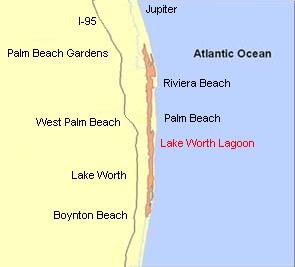Lake Worth Lagoon facts for kids
The Lake Worth Lagoon is a long, narrow body of water in Palm Beach County, Florida. It runs along the coast, separated from the Atlantic Ocean by sandy strips of land called barrier beaches. Palm Beach Island is one of these barrier beaches. The lagoon is connected to the ocean by two man-made channels, called inlets.
Contents
Exploring Lake Worth Lagoon's Location
The Lake Worth Lagoon is found at coordinates 26°40′53″N 80°02′45″W / 26.68139°N 80.04583°W. It stretches about 21 miles (34 km) long and can be up to a mile (1.6 km) wide.
Inlets Connecting to the Ocean
Two important inlets connect the lagoon to the Atlantic Ocean:
- The Lake Worth Inlet is in the northern part. It serves as the main entrance for ships going to the Port of Palm Beach.
- The South Lake Worth Inlet, also called the Boynton Inlet, is in the southern part. This inlet is mostly used by people who enjoy boating for fun.
The Intracoastal Waterway
The Atlantic Intracoastal Waterway runs all the way through the lagoon. This waterway is like a highway for boats, allowing them to travel along the coast.
Bridges and Causeways
There are eight causeways and bridges that connect the mainland to the barrier beaches, including Palm Beach Island. These allow cars and people to cross over the lagoon.
What's in a Name? The Story of Lake Worth
The lagoon is named "Lake Worth" to honor William J. Worth. He was the last commander of United States troops in the Second Seminole War.
The Original Seminole Name
In 1870, a Seminole person shared the original Seminole name for the lagoon: Hypoluxo. This name means "water all around no get out." It described how the lagoon used to be landlocked, meaning it had no easy way to connect to the ocean.
A Look Back: History of Lake Worth Lagoon
In the mid-1800s, the Lake Worth Lagoon was actually a freshwater lake. No rivers flowed into it. All its water came from underground seepage from the Everglades to the west.
When the Lake Was Landlocked
Sometimes, very high tides, big waves, or storms would create temporary openings to the ocean. But these openings would quickly close up again. When there was no opening, settlers had to carry their boats over the barrier beaches to move them between the lake and the ocean.
The First Man-Made Inlet
In 1866, travelers reported that freshwater was pouring from the lake into the ocean. A settler named August Lang had dug this channel to create an inlet. It was known as "Lang's Inlet" for a while. This new cut lowered the lake's water level to match the sea.
Because only a little ocean water came in, and freshwater from the Everglades kept flowing, the lake stayed only slightly salty. Lang's Inlet was not very stable and had to be dug out again every few months.
A Permanent Change
In 1877, a stable inlet was finally built at a place called "Black Rocks," about a mile (1.6 km) north of Lang's Inlet. After this, the lake quickly began to change into a saltwater lagoon. In the 1880s, a navigation canal was finished, connecting the north end of Lake Worth Lagoon to Jupiter Inlet. This brought even more freshwater into the lagoon.
Modern Developments
In the early 1900s, the Atlantic Intracoastal Waterway was completed, connecting the south end of the Lagoon to Biscayne Bay. By 1915, the Port of Palm Beach had created a permanent inlet four feet deep where Lang's Inlet used to be. This inlet was made even deeper, to 16 feet (4.9 m), in 1925.
In 1917, the South Lake Worth Inlet was created. This was an attempt to improve how tides moved water through the southern part of the Lagoon. Also, the West Palm Beach Canal was completed in 1925. This canal connected to Lake Okeechobee and brought a lot of freshwater into the lagoon from lands west of West Palm Beach and the Everglades.
The Mystery of the "Muck Monster"
On August 24, 2009, something strange happened in the lagoon. A local group called the LagoonKeepers filmed an unexplained wake, or ripple, in the water. They named it the "muck monster."
The creature's identity and whether it truly exists are still unknown. It never broke the surface of the water while being watched. It made a wide wake, but then seemed to go deeper when people got within 10 feet of it.


